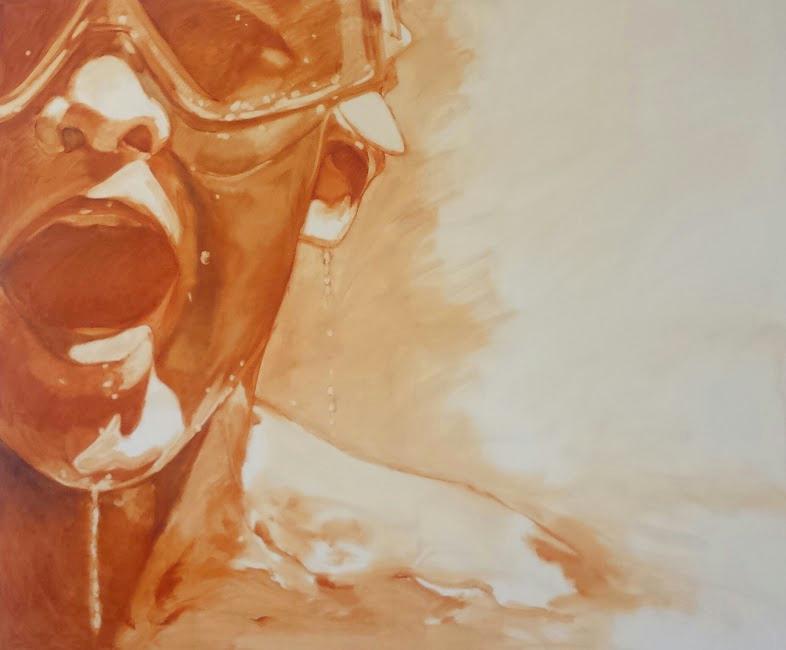|
WAS staff is very happy to introduce our first Artist Tech Tip Local artist Jessica Masters has been kind enough to talk to us about how she chooses an oil primer in her work. We hope you enjoy learning as much as we do! |

I recently wanted to see if using an oil primer would suit the changing needs of my painting style. I wanted to do large scale painting in oil using the subtractive or wipe out method so I needed a smooth, non-absorbent ground to work on. In my quest to find the right primer I tried three brands. Fredrix, Gamblin and Winsor and Newton.
The qualities I considered when choosing which was best for me came down to surface quality, ease of application, drying time, and price.
Here is what I learned:
First up was Fredrix. It was the most expensive at $45.70, but it was also the largest at a 1L can. The application was easy. It was smooth and glossy and went on easily with a brush, then smoothed out with a foam roller. It took two coats (standard) and drying time was seven days before I could paint on it (though drying times are not listed on product).
The surface was nice and smooth to paint on and end results were good. However this was the first oil primer I bought, and I noticed after 1 year that the panels that were primed but not painted on were starting to yellow a bit. I thought this might be from not sealing the wood well enough with PVA size but the paint traces around the rim of the can had done the same. I am not sure what that would do to my paintings over time?

"2 coats of PVA to seal the wood before using primer"
| WAS NOTE: It's a good idea to "size" or seal any surface prior to applying your primer. This helps lock in any impurities present in the substrate to prevent them from leaching up into your painting. It also protects the substrate from oils in your primer and oil paint. |
Next I tried Gamblin’s oil primer, available in three sizes. I purchased the 16oz can for $30.95. The application was tricky. I found it awkward and stiff to work with. You are supposed to apply it with a credit card and then roll it out with a foam roller but I found this took a long time and required a lot of effort because of it’s stiffness...and the next time I used my credit card it was stuck in my wallet (lol!)
The second coat can be applied the next day but it takes about 7 days to be able to paint on it. The surface was very nice to paint so it’s really a matter of whether the effort was worth it...maybe for smaller canvases.
Finally, Winsor and Newton’s oil primer, at $38.50 for 500ml. When this oil primer came out of the can it was exactly how I expected an oil primer to look and feel like. It was buttery and smooth. The application was simple, just brush it on with a household paint brush and roll it out with a foam roller. The whole process was very quick. The second application can be put on a day later and you can start painting as soon as it’s dry. The surface a really nice to paint on.
Overall, I definitely liked the Winsor and Newton primer the best. It had the easiest application, gave a smooth surface to paint on, and was fast drying so I could get on with my work.


More from this artist |
"I paint things that are important to me. Things that have an impact on my life, like my family, my history, and the landscape around me. I've lived in Ontario, Britain, and Quebec, and these places and experiences come out in different ways in the work that I do. Regardless of my subject matter or medium, I strive to create an atmosphere and mood in each piece that viewers can connect with." Jessica works from her own studio in Guelph and teaches courses in both painting and dry pastel. Her work is held in private and corporate collections throughout Canada, United States, Austalia and New Zealand. She also shows her work in several galleries in Toronto, Oakville, Waterloo and in Guelph. |


4 comments
Jon
Thanks Jessica, for an informative and helpful review. :)
janet clattenburg
thank you so much!
Store staff
Hi Janet, good question. Most people using cold wax would prepare their panel with a few coats of acrylic gesso, as though you were priming for oil painting. We recommend a rigid support for cold wax for two reasons – if you intend to use knives, scrapers and spreaders, you may have tension issues with stretched canvas and may hit the stretcher frame beneath the canvas. Also, the more wax medium you use in your paints, the less flexible the dried film, and there is a concern that a flexible support like stretched canvas might cause the painting to crack over time. Hope that helps! W.A.S.
janet clattenburg
Interesting article.I am interested in cold wax and oil painting. How do I prepare the wood panels ? and can you use this on canvases?